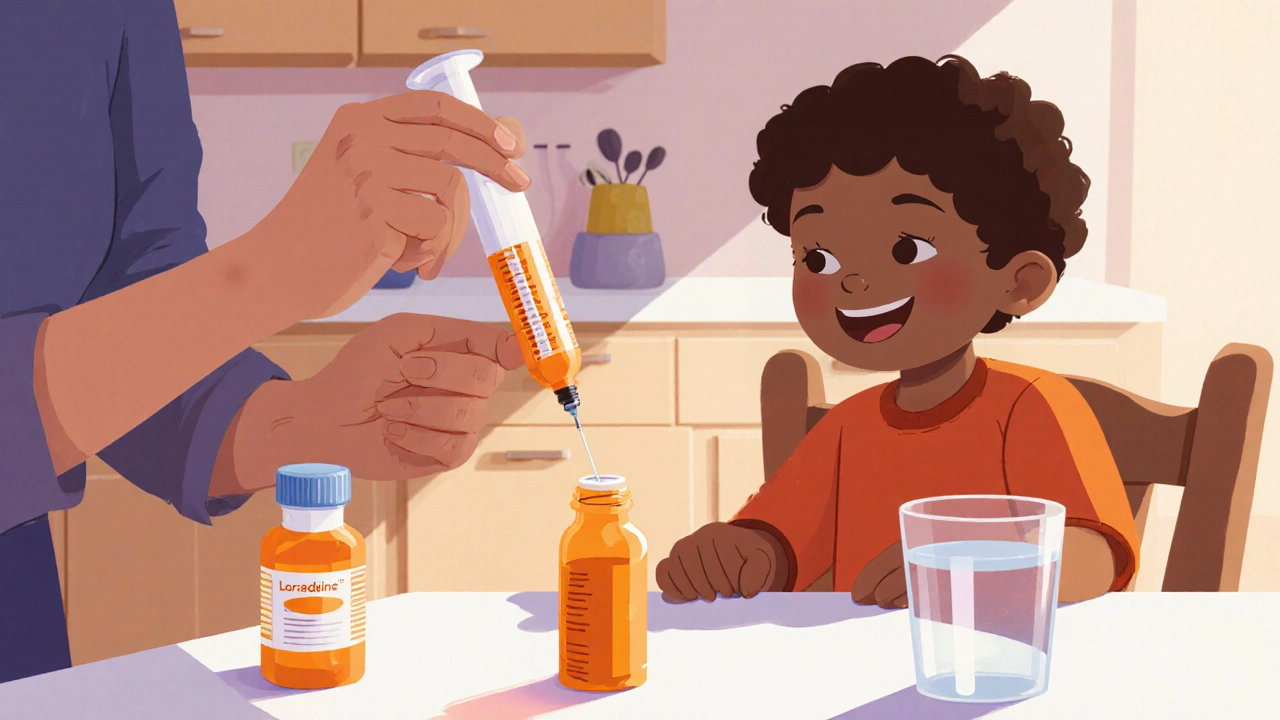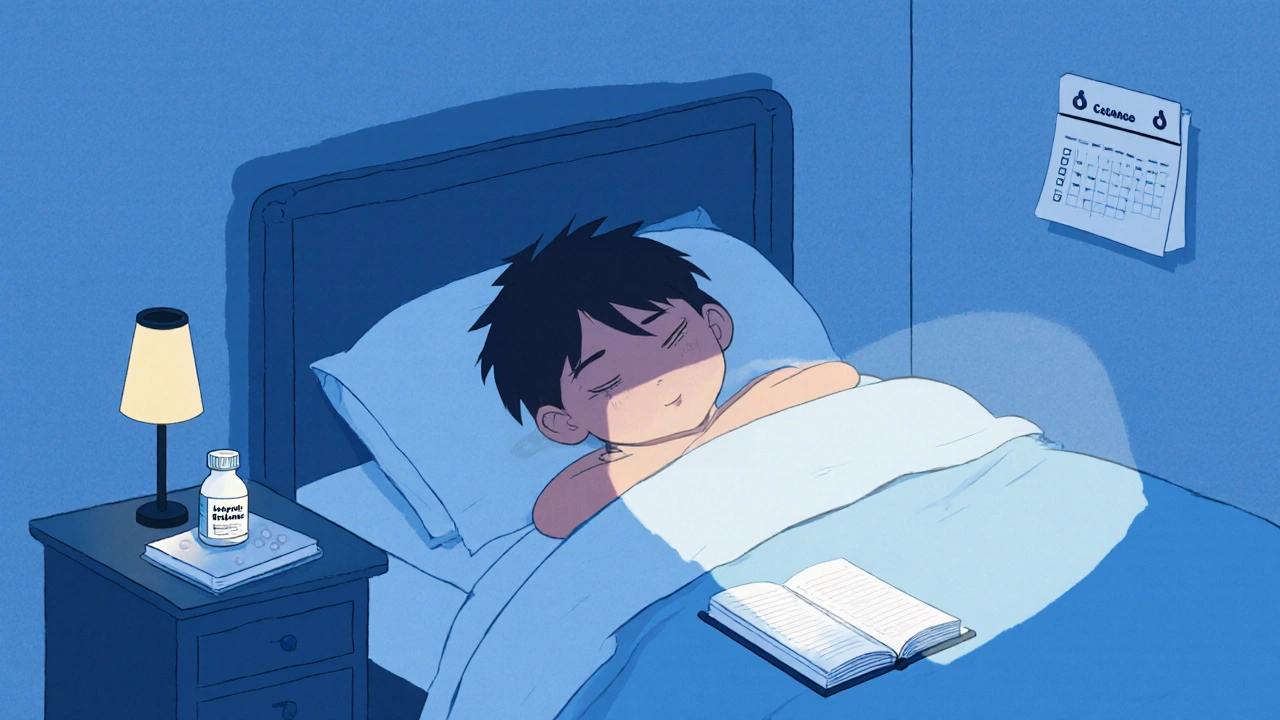Loratadine Dosage Calculator for Kids
Calculate Safe Dosage
Enter your child's age to get the correct loratadine dosage
Important Safety Info
WARNING: Never combine loratadine with other antihistamines unless directed by a doctor.
Certain antibiotics and antifungals may increase loratadine levels.
Select your child's age to see recommended dosage
When a sudden sneeze marathon hits your child, the instinct is to reach for the medicine cabinet. But not every allergy pill is created equal for little bodies. Knowing how to give loratadine dosage for children safely can turn a stressful evening into a calm night’s sleep.
Quick Takeaways
- Loratadine is an over‑the‑counter (OTC) antihistamine approved for children 2 years and older.
- Dosage is age‑based: 5 mg once daily for 2‑5 years, 10 mg once daily for 6 years and up.
- Common side effects are mild - headache, dry mouth, or slight fatigue.
- Never combine loratadine with other antihistamines unless a doctor says so.
- Keep a medication list handy; certain antibiotics and antifungals can raise loratadine levels.
What Is Loratadine?
Loratadine is a second‑generation antihistamine that blocks H1 receptors, reducing the body’s response to histamine released during allergic reactions. It was first approved by the U.S. Food and Drug Administration (FDA) in 1993 and has since become a staple for seasonal allergic rhinitis, hives, and eye irritation.
How Loratadine Works in a Child’s Body
Histamine binds to H1 receptors in the nose, throat, and skin, causing itching, swelling, and mucus production. By occupying these receptors, loratadine stops histamine from triggering those symptoms. Because it stays largely outside the brain, it causes far less drowsiness than older antihistamines like diphenhydramine.
Safety Profile for Kids
Clinical trials involving more than 5,000 children aged 2‑12 years showed that loratadine’s safety is comparable to placebo. The most frequently reported adverse events were:
- Headache (≈4 % of users)
- Dry mouth (≈3 %)
- Transient fatigue (≈2 %)
Serious reactions-such as severe rash or breathing trouble-are rare (<0.1 %). If any of these occur, stop the medication and contact a pediatrician immediately.

Correct Dosage: Age and Weight Matters
The Pediatric dosage guidelines for loratadine are simple, but it’s worth double‑checking the numbers on the bottle.
- Children 2‑5 years (10‑20 lb): 5 mg once daily (half a 10 mg tablet or 5 ml of syrup).
- Children 6‑11 years (21‑55 lb): 10 mg once daily (a full 10 mg tablet or 10 ml of syrup).
- Adolescents 12 years and older: the adult dose of 10 mg once daily is safe.
If a child’s weight is at the low end of the age bracket, a pediatrician may recommend the lower dose to avoid over‑medication. Always use the measuring syringe that comes with the syrup for accuracy.
Practical Tips for Giving Loratadine
- Consistency is key: give the dose at the same time each day, preferably with breakfast or lunch.
- Do not crush or chew tablets for children under 6: the drug’s coating controls the release rate. Use the liquid form instead.
- Store in a cool, dry place: extreme heat can degrade the active ingredient.
- Monitor the child’s response for the first 48 hours: keep a simple log of symptoms and any side effects.
When to Seek Medical Help
Most side effects settle within a day or two. However, call a doctor if you notice:
- Persistent vomiting or diarrhea.
- Rapid heartbeat or palpitations.
- Swelling of the face, lips, or tongue.
- Skin that develops blisters or a widespread rash.

Drug Interactions to Watch
Loratadine is metabolized mainly by the liver enzyme CYP3A4. Certain drugs can inhibit or induce this enzyme, changing loratadine levels.
- Inhibitors (increase loratadine): erythromycin, ketoconazole, ritonavir.
- Inducers (decrease loratadine): carbamazepine, phenytoin, rifampin.
- Alcohol can heighten drowsiness, even though loratadine is non‑sedating.
Always tell the pediatrician about any prescription meds, over‑the‑counter drugs, or herbal supplements your child is taking.
Comparing Loratadine with Other Pediatric Antihistamines
| Attribute | Loratadine | Cetirizine | Diphenhydramine |
|---|---|---|---|
| Generation | Second | Second | First |
| Typical pediatric dose (2‑5 y) | 5 mg once daily | 2.5 mg once daily | 12.5 mg every 4‑6 h |
| Onset of relief | 1‑3 h | 1‑2 h | 30‑60 min |
| Duration | 24 h | 24 h | 4‑6 h |
| Sleepiness risk | Low | Low‑moderate | High |
| OTC status (U.S.) | Yes | Yes | Yes (often behind the counter) |
For most children, loratadine offers the best balance of once‑daily dosing and low sedation. Cetirizine is a close runner‑up but can cause mild drowsiness in some kids. Diphenhydramine is best reserved for short‑term use (e.g., an acute allergic reaction) because of its sleep‑inducing profile.
Special Situations
- Asthma: Loratadine does not treat asthma itself, but it can lessen allergy‑triggered bronchospasm. Continue prescribed inhalers.
- Travel: Pack a child‑friendly dosing device and a written copy of the dosage schedule in case you need to explain to a pharmacist abroad.
- Feeding tubes: Liquid form can be administered via syringe; avoid crushing tablets.
Frequently Asked Questions
Can I give loratadine to a child younger than 2 years?
No. The FDA has only approved loratadine for children 2 years and older because safety data for infants are insufficient.
Does loratadine cause drowsiness?
It is classified as non‑sedating, so most children stay alert. A small minority may feel mildly sleepy, especially if taken on an empty stomach.
How long does it take for loratadine to start working?
Typically 1‑3 hours after the dose, with full effect reached by the evening of the first day.
Can I use loratadine syrup instead of tablets for a 7‑year‑old?
Yes, but the syrup - 5 mg per 5 ml - must be measured exactly. Tablets are fine if your child can swallow them whole.
What should I do if I miss a dose?
Give the missed dose as soon as you remember, unless it’s almost time for the next scheduled dose. In that case, skip the missed one - don’t double up.
Is it safe to combine loratadine with a nasal spray?
Yes. Saline or steroid nasal sprays are often used together and do not interact with loratadine.
Armed with these facts, you can make an informed decision about loratadine for your child. Remember: the goal is to keep symptoms under control without adding new worries.



James Dean
Sometimes the simplest remedy is the one that respects the child's rhythm. Loratadine in the right dose fits that idea like a quiet bridge over an itchy storm. Think about how the body processes a drug, it’s not magic but chemistry that can be measured. A calm night often starts with a measured spoonful, not a frantic search. Stay aware of the age guidelines and you’ll avoid most of the hassle.